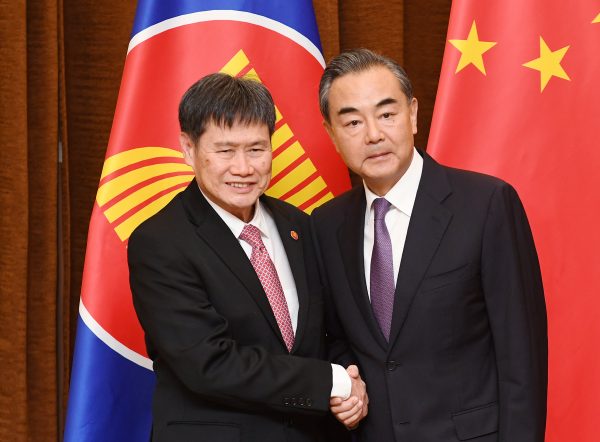ASEAN-5 — Singapore, Thailand, Malaysia, Indonesia and Vietnam — collectively constituted 84 per cent of ASEAN’s US$3.1 trillion GDP in 2019 and accounted for over 90 per cent of its trade and investment flows. Data analysis of trade in goods for 2015–2019 reveals that the main geopolitical blocs consisting of the ‘US alliance’, ‘Atlantic alliance’ and ‘China bloc’ did not evolve as a share of ASEAN-5’s economies. The China bloc — China, Hong Kong and Macao — represented 20 per cent of trade with ASEAN-5 in 2015, and 21 per cent in 2019.
The US alliance — Japan, South Korea, Thailand and Australia — leads trade with ASEAN-5, adding US$143 billion over five years to reach US$741 billion in 2019. The China bloc only reached US$543 billion. The Atlantic alliance consisting of the United States and European Union added US$117 billion, growing from 19 per cent to 21 per cent of ASEAN-5 trade.
ASEAN-5 is not becoming reliant on trade with China. Trade in goods as a percentage of GDP reflects economic interdependence. From 2015 to 2019, the US alliance and the Atlantic alliance maintained a level with ASEAN-5 of 29 and 20 per cent, respectively. ASEAN-5’s ratio with the China bloc decreased from 20 to 18 per cent. Only Vietnam significantly increased trade in goods with the China bloc, rising from 38 to 48 per cent. But Vietnam also boosted the same ratio with the US alliance, rising from 63 to 79 per cent.
On the Foreign Direct Investment (FDI) front, China remains a relatively small player. The US and Atlantic alliances still dominate ASEAN-5’s investment landscape. From 2015 to 2019, the US and Atlantic alliances cumulatively invested US$346 billion, more than three times the US$99 billion bankrolled by the China bloc in ASEAN-5.
The average FDI inflow into ASEAN-5 stood at US$144 annually between 2015 and 2019. The China bloc increased its FDI from US$7.9 to US$21.9 billion, pushing its share of the ASEAN-5’s FDI inflow from 7 per cent to 12 per cent. Meanwhile, the US alliance increased its FDI from US$43.9 to US$70.9 billion, causing its share of ASEAN-5’s FDI inflow to rise from 37 per cent to 39 per cent.
On the annual importance of FDI inflow as a proportion of ASEAN-5 GDP, China went from 0.4 per cent in 2015 to 0.8 per cent in 2019. The US alliance went from 2.1 per cent in 2015 to 2.7 per cent in 2019, reinforcing its position. The China bloc’s share of FDI stock grew from 6 per cent in 2015 to 8 per cent in 2019. Over the same period, the Atlantic alliance and the US alliance remained relatively constant at 37 per cent and 31 per cent respectively.
The much lauded Belt and Road Initiative (BRI) is not as large as has been trumpeted, despite the US$739 billion pledged to ASEAN. The BRI accounted for US$9 billion in annual investment into ASEAN-5’s US$144 billion average annual FDI inflows. For the last five years, the BRI has contributed US$4 billion to the Indonesian annual average FDI inflow of US$17 billion, and US$1.5 billion to the Malaysian average annual FDI inflow of US$10 billion. Thailand has not received any BRI investment so far, rebutting the country’s tilt towards China narrative.
While the BRI benefits select countries, it is not shifting ASEAN-5’s allegiances. The BRI also faces pushback, and is unpopular at home while its funding challenges and completion difficulties continue to accumulate. Contrary to what media reports suggest about China achieving diplomatic leverage through its oversized trade and investment involvement, China’s economic role has remained stable over the last five years.
China’s involvement in Southeast Asia should not trigger concern over a mercantile system. The China bloc’s focus on its domestic market and mounting mistrust it has faced in ASEAN countries have stalled its trade leverage, particularly as ASEAN-5 has maintained a carefully diversified trade and investment portfolio.
Competition can actually empower ASEAN-5 to extract trade concessions and investments from both sides — Vietnam is a typical case. While the economic data disproves the existence of an ASEAN dependency threat, this does not mean that China no longer poses security concerns in the region. But the link between China’s economic involvement and a security risk is weak at best. So far, ASEAN-5 has not tilted toward China.
Christian Bachheimer is a Doctoral Researcher at the School of Oriental and African Studies, University of London.

